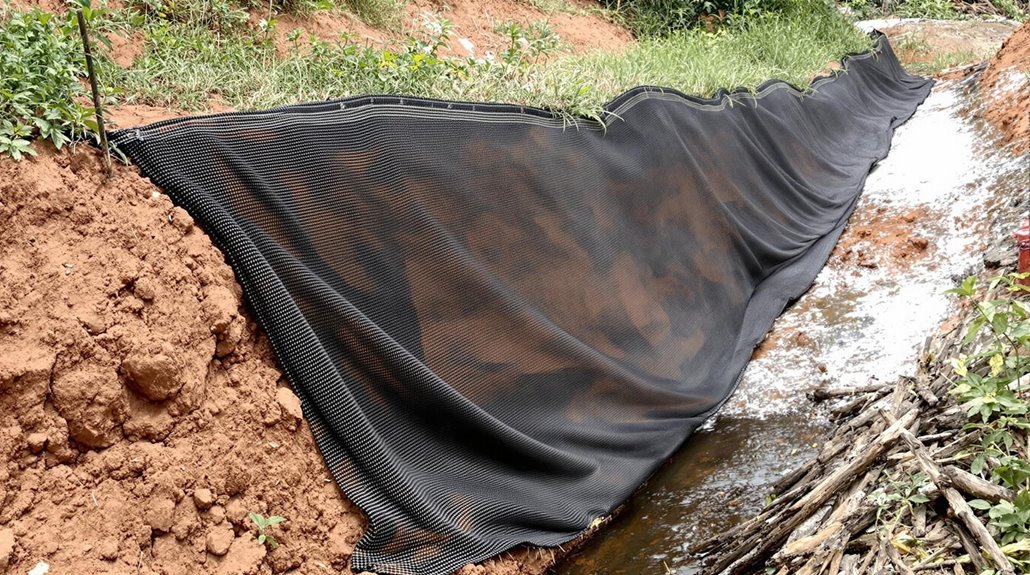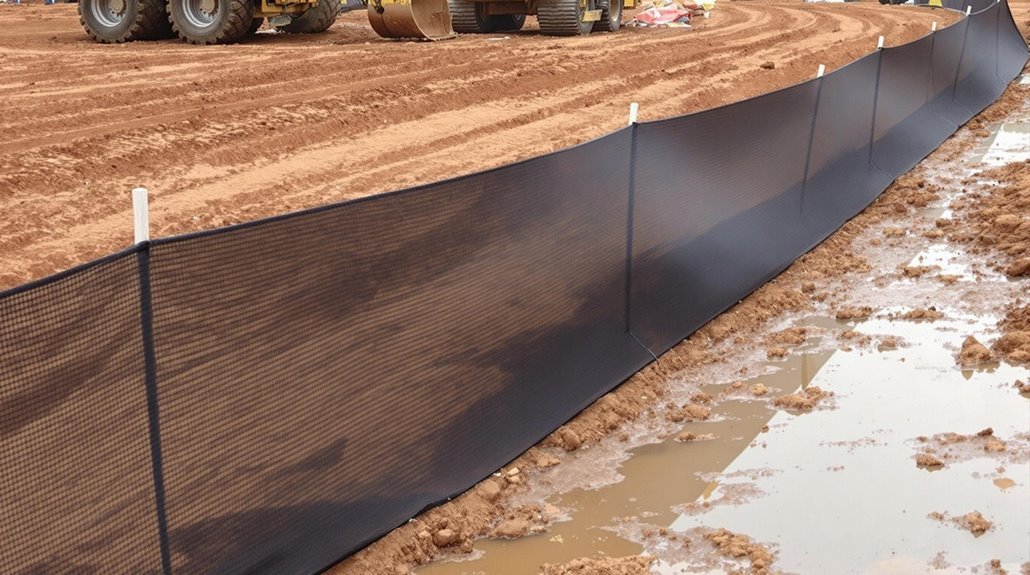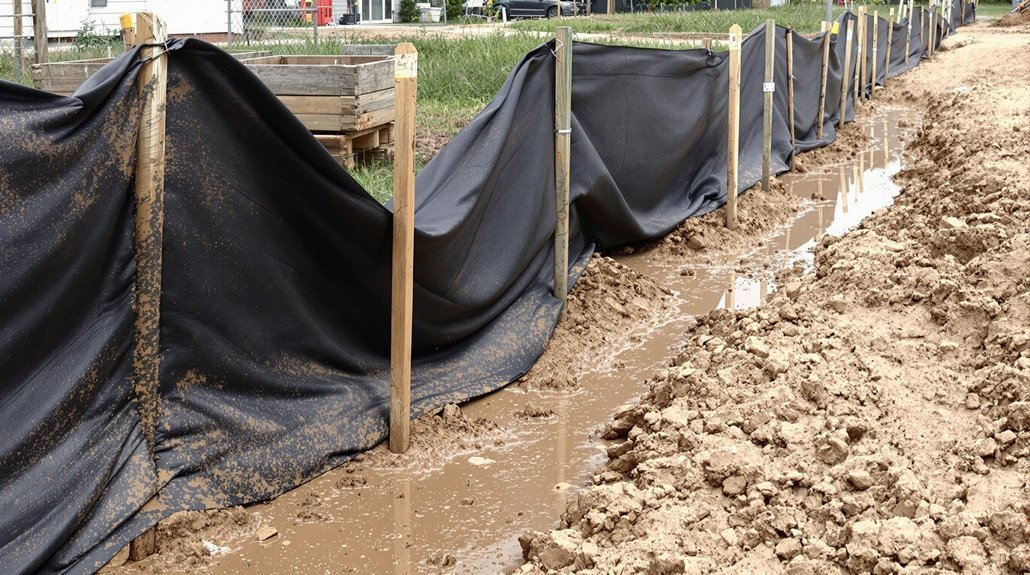A silt fence is a temporary barrier we use on construction sites to control sediment runoff and protect water quality. We make these fences from permeable geotextile fabric stretched between support posts, allowing water to filter through while trapping soil particles. They’re essential for preventing erosion, establishing vegetation, and maintaining compliance with environmental regulations. We’ll typically install them along contour lines, securing the fabric in a trench with properly spaced stakes for maximum effectiveness. From basic woven materials to heavy-duty reinforced options, there’s much more to understand about selecting and installing the right silt fence for your project.
What Is A Silt Fence

A silt fence is a temporary sediment control barrier used at construction sites to prevent soil erosion and protect water quality.
It’s constructed using permeable filter fabric stretched between support posts that are firmly driven into the ground. One of the key silt fence benefits is its ability to trap sediment while allowing water to seep through, making it an effective perimeter control solution.
We install these barriers along slopes and site perimeters, but they shouldn’t be placed in areas of concentrated water flow.
While installation challenges can arise, particularly during the trenching process, newer methods like static slicing have improved efficiency.
The fence must be properly maintained, with regular inspections and sediment removal when buildup reaches 6 inches.
It’s designed to handle runoff from 10-year peak storm events.
Purpose And Environmental Benefits

Building on our understanding of silt fence construction, let’s explore why these barriers serve such an important role in environmental protection.
Silt fence advantages extend far beyond simple erosion prevention, as they help maintain the delicate balance of our local ecosystems while supporting sustainable development.
- Protects water quality by filtering out sediments and preventing pollution from entering waterways
- Preserves valuable topsoil and prevents landscape degradation through effective erosion control
- Maintains healthy aquatic ecosystems by reducing water turbidity and protecting spawning grounds
- Supports local wildlife by minimizing disruption to habitats and migration patterns
- Guarantees compliance with environmental regulations while balancing economic development needs
We’re committed to implementing these important barriers correctly, recognizing their vital role in preserving our natural environment for future generations.
Types Of Silt Fences

Understanding silt fence types helps contractors and developers choose the right solution for their specific erosion control needs.
We classify silt fences by both their fabric and construction methods. The fabric options range from basic economy grade to high-performance monofilament, each offering different levels of silt fence durability and filtration.
Construction types include Type A with 36-inch fabric for larger projects, Type B with 22-inch fabric for smaller sites, and Type C with wire mesh reinforcement for high-runoff areas.
The silt fence materials used in construction vary from woven slit films to reinforced options with chain link fencing.
For maximum strength, super silt fences incorporate galvanized line poles and are ideal for high-impact sites where standard installations won’t suffice.
Proper Installation Methods

Proper installation of silt fences demands both technical precision and careful attention to proven methods. We recommend two primary installation approaches: the static slicing method and the trenching method. Both techniques require specific steps to guarantee maximum effectiveness.
Key installation requirements include:
- Drive posts 2 feet deep, spacing them 3-7 feet apart based on water flow conditions
- Attach heavy porous filter fabric tightly using staples or zip ties
- Compact soil thoroughly on both sides to prevent water infiltration
- Create proper depth – 12 inches for static slicing, 8-12 inches for trenching
- Monitor and maintain regularly, especially after rainfall
We find that static slicing often provides superior results due to minimized soil disruption and better compaction.
Though both methods can be effective when executed correctly.
Best Practices For Location

When it comes to silt fence placement, location can make or break your erosion control efforts. For effective sediment control, we’ll help you strategically position your silt fences based on proven design principles. We recommend placing fences along contours, with multiple runs on longer slopes to create manageable storage areas.
| Slope Grade | Maximum Spacing | Storage Area |
|---|---|---|
| 3%-5% | 100 feet | 1/4 acre/100ft |
| 5%-10% | 75 feet | 1/4 acre/100ft |
| >10% | 50 feet | 1/4 acre/100ft |
For ideal silt fence design, install fences downhill from disturbed areas, maintaining a setback from the slope toe for maintenance access. Remember to avoid placement in channels with continuous flow, and verify your fence height stays between 18-30 inches for maximum effectiveness.
Construction Site Applications

Throughout the construction industry, silt fences play an essential role in environmental protection and site management.
We’ve found that proper silt fence materials and installation equipment are vital across various construction applications.
Here’s where we commonly implement silt fences:
- Residential projects to prevent sediment from entering water sources during home construction
- Commercial sites to control runoff from large-scale earthwork activities
- Industrial construction areas to manage heavy equipment impact and soil displacement
- Road construction zones to maintain terrain stability during grading
- Water-adjacent projects to protect streams and rivers from contamination
When we install silt fences at these sites, we’re not just meeting regulatory requirements – we’re actively protecting the environment while ensuring project efficiency.
Our installation methods adapt to each specific application, considering factors like terrain, project scale, and local environmental concerns.
Maintenance Requirements

At NorCal Erosion Control, we’ll help you establish a weekly inspection schedule for your silt fences, with additional checks after heavy rainfall to catch potential issues early.
We can guide you through proper sediment removal techniques once accumulation reaches half the fence height, ensuring your barriers maintain peak performance.
Our expert team is ready to respond quickly to emergency repairs, fixing tears, stabilizing loose posts, and addressing any storm damage to keep your erosion control system working effectively.
Regular Inspection Schedule
To maintain the effectiveness of your silt fence, regular inspections must follow a consistent schedule that includes routine, pre-rain, and post-rain checks.
We recommend creating detailed inspection checklists and establishing consistent inspection intervals to guarantee nothing is overlooked.
- Conduct routine inspections every 7-14 days, depending on your site’s risk level.
- Perform pre-rain inspections within 24 hours of forecasted storms to verify ESC functionality.
- Complete post-rain inspections within 48 hours to assess damage and needed repairs.
- Check sediment accumulation levels, which shouldn’t exceed one-third of fence height.
- Examine fabric condition, post stability, and potential gaps during each inspection.
In arid regions, we can adjust inspection frequencies based on local conditions and regulations, but it’s vital to maintain thorough documentation of all inspections and any corrective actions taken.
Sediment Removal Process
Building on our inspection protocols, proper sediment removal stands as a cornerstone of effective silt fence maintenance. We recommend removing sediment deposits when they reach half the fence height to prevent sagging and potential collapse.
Using a backhoe or similar equipment, we carefully extract the accumulated material without undercutting the fence structure.
For sediment disposal, we’ll guarantee compliance with local regulations while implementing proper stabilization measures. After removal, we grade the area to match the existing topography and establish vegetation for long-term soil stability.
On sites with space limitations, we might suggest installing a new silt fence above or below the existing one.
Emergency Repair Protocols
Professional maintenance teams understand that swift action during emergencies keeps silt fences functioning properly.
Our repair techniques focus on immediate response to damage after rainfall events, ensuring continuous protection against sediment runoff. We implement emergency actions that address issues before they escalate into bigger problems.
- We perform daily inspections during prolonged rainfall to catch problems early
- We quickly repair or replace damaged geotextile fabric sections
- We stabilize and retension loose support stakes immediately
- We check for and prevent water infiltration or bypass issues
- We document all repairs to maintain regulatory compliance
Common Installation Mistakes

While installing a silt fence may seem straightforward, our team at NorCal Erosion Control frequently encounters several common mistakes that can compromise its effectiveness.
Throughout silt fence history, we’ve observed that incorrect placement remains one of the biggest installation challenges, often occurring when fences aren’t aligned with contour lines or properly positioned for water flow patterns.
We commonly see inadequate trenching, where contractors dig trenches too shallow or fail to compact the soil properly.
Poor fabric installation, including loose material and insufficient overlap between sections, can create gaps that allow sediment to escape.
Additionally, structural failures often result from improper stake spacing and depth.
At NorCal Erosion Control, we prevent these issues through careful site assessment and precise installation techniques.
Regulatory Guidelines And Standards

At NorCal Erosion Control, we guarantee all silt fence installations meet strict regulatory requirements that govern their design and implementation. Our commitment to regulatory compliance guarantees your project aligns with federal, state, and local sediment control standards.
Key compliance requirements we follow include:
- Proper permitting for construction sites disturbing over one acre
- Adherence to EPA and Clean Water Act regulations
- Integration with thorough Stormwater Pollution Prevention Plans (SWPPP)
- Documentation of all maintenance activities and adjustments
- Compliance with state-specific Best Management Practices (BMPs)
We maintain detailed records of installations and inspections to guarantee ongoing compliance.
Our expertise in regulatory guidelines helps protect your project from potential violations while delivering effective erosion control solutions that meet or exceed all standards.
Frequently Asked Questions
How Much Does Professional Silt Fence Installation Typically Cost per Linear Foot?
We’ll install your fencing at $1-3 per linear foot, though installation factors and material types can push costs to $20-30 per linear foot for premium options with specialized requirements.
Can Silt Fences Be Reused on Different Construction Projects?
We don’t recommend reusing silt fences since proper silt fence maintenance and effectiveness depend on new materials. Weather exposure, soil contamination, and wear typically compromise their structural integrity between projects.
What Is the Average Lifespan of a Properly Maintained Silt Fence?
We’ve found that properly maintained fences last 6-12 months with quality silt fence materials and correct installation techniques. Regular inspections help extend lifespan, though weather conditions can impact durability.
Do Silt Fences Require Special Permits Before Installation?
We’ll help you navigate silt fence regulations and installation guidelines. Most areas require permits for large construction sites or environmentally sensitive areas, but requirements vary by location and project scope.
How Quickly Can Sediment Build up During Heavy Rainfall Events?
We’ve seen sediment accumulation happen rapidly during heavy rainfall, with significant buildup occurring in just hours. The rainfall impact can deposit several tons of material surprisingly fast.

